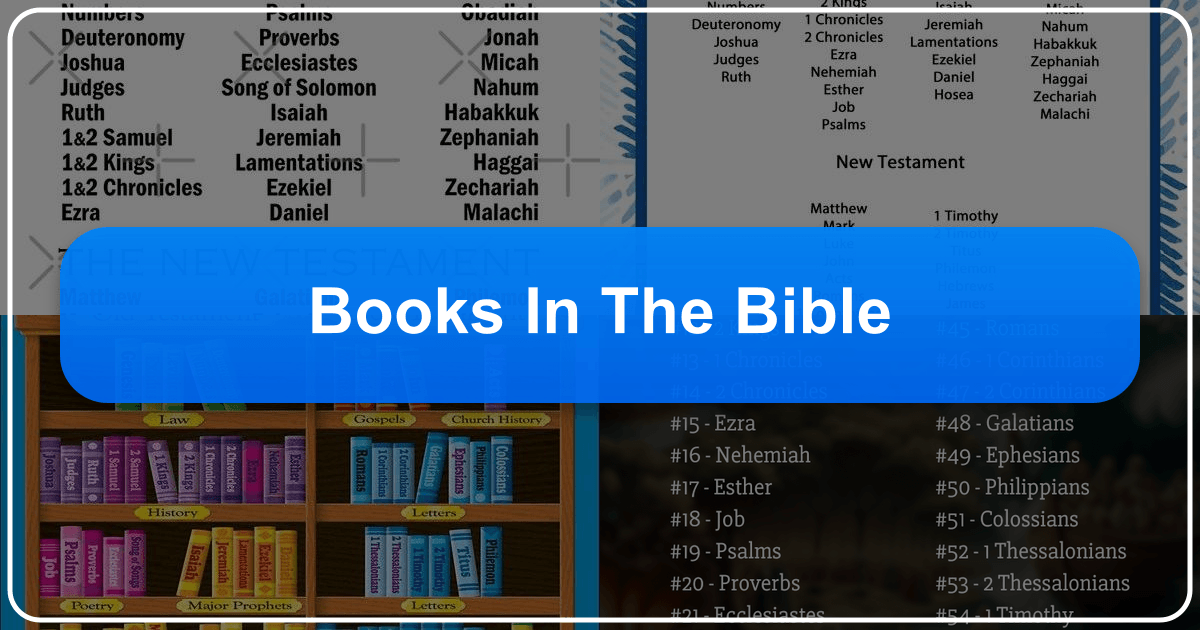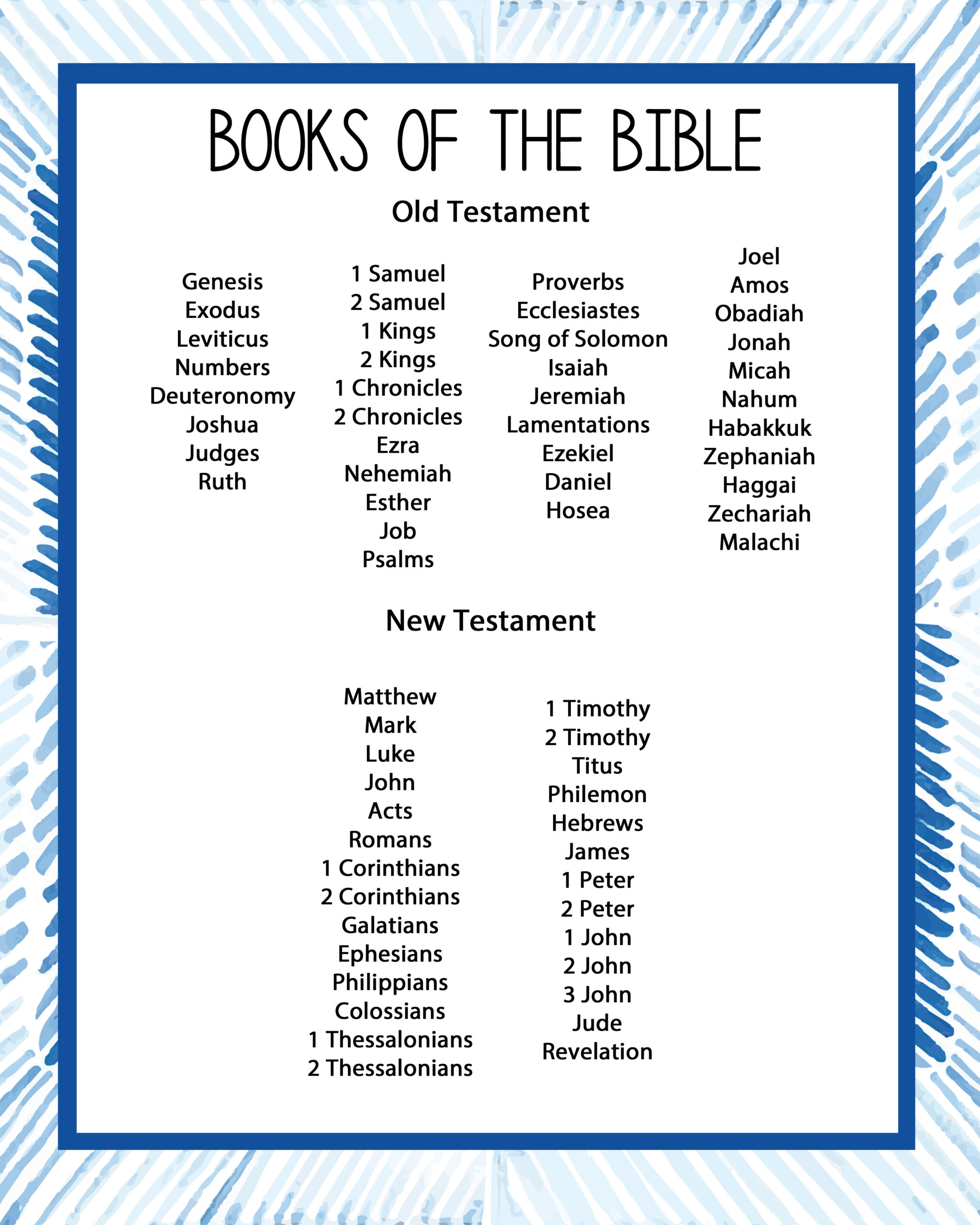The Books of the Bible: A Comprehensive Guide

The Bible, a collection of sacred texts revered by billions, isn’t a single book but a library of 66 individual books spanning millennia. Understanding its structure, the genres it encompasses, and the historical and cultural context surrounding its creation is crucial to appreciating its enduring influence. This comprehensive guide will delve into the various aspects of the Bible, exploring its composition, its message, and its lasting impact on the world. We’ll examine the books themselves, the authors, the themes, and the enduring legacy this collection holds.
The Canonical Books: A Closer Look

The Bible is traditionally divided into two major sections: the Old Testament and the New Testament. The Old Testament, primarily focusing on the history, laws, and prophecies concerning God’s covenant with the Israelites, contains 39 books. The New Testament, narrating the life, teachings, death, and resurrection of Jesus Christ, and the subsequent development of the early Christian church, includes 27 books. The precise number and order of books can vary slightly depending on the tradition (Catholic, Protestant, Orthodox), with some traditions including additional books classified as deuterocanonical or apocryphal.
Genres within the Bible
The Bible isn’t monolithic in its genre; instead, it employs a rich tapestry of literary styles to convey its message. These include:

- Narrative: Large portions of both testaments recount historical events, creating captivating stories that transmit key theological insights. Examples include the creation narrative in Genesis, the exodus story in Exodus, the biographies of Kings and Prophets, and the Gospels in the New Testament.
- Poetry: The poetic books like Psalms, Proverbs, and Song of Solomon utilize vivid imagery, metaphor, and parallelism to express profound emotions, wisdom, and spiritual truths. The poetic nature enhances memorability and emphasizes the emotional connection to divine guidance.
- Prophecy: Books attributed to the prophets, both major (Isaiah, Jeremiah, Ezekiel, Daniel) and minor (Hosea, Joel, Amos, etc.), convey God’s messages of judgment, warning, and hope for the future. These prophecies often utilize symbolic language, parables, and visions to communicate complex theological ideas.
- Law: The Pentateuch (the first five books of the Old Testament) establishes the legal and ethical framework for Israel’s relationship with God. These laws cover various aspects of life, from religious practices to social justice and moral conduct.
- Epistles: The New Testament features letters written by Paul and other apostles to individuals and churches, addressing specific theological issues, offering pastoral guidance, and conveying instructions for Christian living.
- Apocalyptic Literature: The Book of Revelation utilizes symbolic language and visions to depict the ultimate triumph of good over evil, a common theme in apocalyptic writing.
The Authors and Their Voices
The Bible’s authorship is diverse, with texts attributed to kings, prophets, poets, apostles, and anonymous authors. The diverse backgrounds of these authors enrich the narrative with varying perspectives and styles. Understanding the historical and cultural contexts in which these books were written is critical to interpreting their messages accurately.
Understanding Authorship Attributions
While many books are explicitly attributed to certain figures (e.g., the Gospels to Matthew, Mark, Luke, and John), the authorship of others is debated or unknown. Careful textual analysis, historical research, and considerations of literary style are employed to attempt to determine authorship. The process of establishing authorship is complex and ongoing, and various scholarly opinions exist.

The Influence of Cultural Context
The writers of the Bible were deeply rooted in their respective cultural and historical periods. Understanding their context, including political events, social customs, and religious practices, is crucial for interpreting the texts appropriately. This context provides insight into the meaning and purpose of the writing, avoiding misinterpretations based on modern cultural assumptions.
Reading and Learning from the Bible
The Bible has served as a source of spiritual guidance, moral instruction, and inspiration for countless individuals across cultures and generations.
Exploring Educational Value
The Bible’s educational value extends beyond religious instruction. It offers profound insights into human nature, relationships, morality, history, and social justice. Its stories, parables, and poetic expressions convey timeless lessons applicable to various aspects of life.
Unpacking Life Lessons
The Bible’s narratives and teachings are packed with powerful life lessons that can guide individuals toward ethical conduct, compassion, resilience, and spiritual growth. The stories provide examples of both triumph and failure, allowing readers to learn from the experiences of biblical characters.
Developing Effective Reading Habits
Approaching the Bible requires a thoughtful and multifaceted approach. Contextual understanding, engaging with different translations, seeking scholarly insights, and reflecting on personal applications are all vital aspects of reading the Bible effectively. Developing a habit of consistent engagement, reflection, and prayer allows readers to develop a deeper spiritual relationship with the text.
The Bible in Libraries and Archives
The Bible’s enduring significance is reflected in its presence in libraries and archives worldwide. Its translations, interpretations, and impact are documented extensively in various collections.
Public and Digital Libraries
The Bible is readily accessible in countless public and digital libraries across the globe, reflecting its widespread influence. Digital libraries provide online access to diverse translations, commentaries, and scholarly resources, allowing widespread study and engagement.
Rare Collections and Archives
Numerous rare and valuable Bibles, manuscripts, and related documents are housed in specialized archives and libraries. These collections provide researchers with crucial insights into the history of biblical texts, translations, and interpretations.
The Cultural Impact of the Bible
The Bible’s impact on Western civilization, art, literature, and law has been profound and lasting.
Literary Influence
The Bible’s narratives, poetry, and wisdom literature have served as inspiration and source material for countless authors throughout history. Its imagery, symbolism, and themes have influenced the development of Western literature in profound ways.
Adaptations and Interpretations
The Bible has been adapted into countless films, plays, musicals, and other art forms. These adaptations, while varied, often reflect cultural interpretations of the biblical text.
Awards and Recognition
Numerous books, films, and artistic works inspired by the Bible have received prestigious awards and recognition, indicating its ongoing cultural relevance.
Communities and Faith Traditions
The Bible has shaped communities and faith traditions globally. Its teachings, ethical guidelines, and spiritual insights have had a deep influence on diverse cultures. Different interpretations and traditions often shape the way communities approach and engage with the Bible.
This comprehensive overview provides a foundation for further exploration of the books of the Bible, its rich history, and its profound impact on human culture. Through understanding its literary genres, diverse authors, enduring lessons, and enduring legacy, readers can gain a richer appreciation for this monumental work and its influence throughout the ages.